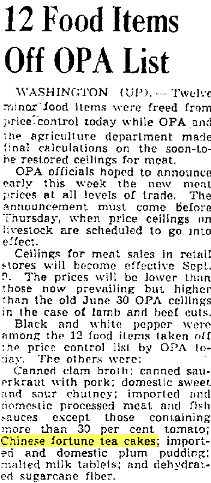Anyone who has ever eaten at a Chinese restaurant or ordered something knows it: the side dish is almost always a biscuit with a note inside.
“Happiness is like a bird, if you don’t grab it, it will fly away.” or “The noble person demands everything from himself, the primitive person only makes demands of others,” are the sayings that are on the pieces of paper inside find these cookies.
They are usually based on Chinese proverbs or quotes from the Chinese scholar Confucius. But how Chinese are these fortune cookies really?
Is that the origin?
On many pages with sayings from the fortune cookies it is stated that the origin of the cookies dates back to the 13th century. At that time, the Mongols were occupying China, and the Chinese who were planning an uprising wrote their plans on small pieces of paper which they hid in pastries. This is said to have been the birth of Chinese fortune cookies.
It cannot be proven without a doubt whether the Chinese actually hid pieces of paper in mooncakes (not cookies) to transmit messages, but it is conceivable, as it is also known from other peoples at different times that secret plans and things were carried out in this way messages were transmitted.
This method can therefore be doubted as the true origin of fortune cookies.
And where do they come from then?
These fortune cookies were already known in the USA, specifically in San Francisco, during the Second World War, but at that time they were still called “Fortune Tea Cakes”. This name is already an indication of where the cookies actually come from, because the Chinese don't actually serve “cakes” (cakes or cakes) with tea. However, this tradition is better known among the Japanese.
Many U.S. soldiers at the time dined in San Francisco while stationed there. Back in their home states, they often asked why these “Chinese cookies” weren’t served there too. These fortune cookies became so famous that in 1946 they even in a list of foods that are not subject to price controls under the name “Chinese fortune tea cakes”:

But the history of cookies can be traced back even further, as these cookies were first served in San Francisco.
Makoto Hagiwara, a Japanese immigrant, worked in a Japanese tea garden in San Francisco's Golden Gate Park in the early 20th century. The exact time cannot be determined, but sometime between 1907 and 1914, fortune cookies were served there with tea for the first time. However, he did not make the cookies himself, but ordered them from a Japanese bakery called “ Benkyodo .” At that time they even had an extra machine for making fortune cookies. The machine's grilles are engraved with the letters "HM" - Hagiwara Makoto (in Japanese, the last name is always given first).
But how did Japanese cookies end up in Chinese restaurants?
During the 1920s and 1930s, many Japanese immigrants opened chop suey restaurants that served Chinese specialties adapted from American cuisine. The dishes were known to many Japanese people because they lived in certain neighborhoods with Chinese immigrants at the time, especially in Los Angeles.
Chinese restaurants were also well attended back then. Since there was a ban on alcohol at the time, many pubs and restaurants went bankrupt. Chinese restaurants, on the other hand, were not dependent on alcohol sales like other businesses, but they offered sophisticated dishes and the fortune cookies as a special feature.
However, in 1942, after the attack on Pearl Harbor in December 1941, all Japanese in the USA were arrested and their restaurants were closed. At the same time, the Chinese immigrants' restaurants were now flourishing, also because meat was in short supply at the time and Chinese cuisine only uses a small amount of meat. And they finally adopted the fortune cookies, which were originally made famous by a Japanese man.
Conclusion
Even if they still have the name “Chinese fortune cookies” today, that is not entirely correct: it was a Japanese man who had these cookies made for the first time and made them famous.
Notes:
1) This content reflects the current state of affairs at the time of publication. The reproduction of individual images, screenshots, embeds or video sequences serves to discuss the topic. 2) Individual contributions were created through the use of machine assistance and were carefully checked by the Mimikama editorial team before publication. ( Reason )

